The Rock Covered Bridge and Zimmerman Covered Bridge National Register nominations note that Schuylkill County once had fifty-one covered bridges. By the time the nominations were written in 1977, the total count was down to two.
Both are owned by Schuylkill County, who appreciate the structures’ place in regional history and the importance of their long-term preservation. Rock Covered Bridge, which crosses Lower Little Swatara Creek in Washington Township, was rehabilitated in 2015. Two miles to the west, the County and Pennsylvania Department of Transportation (PennDOT) completed the rehabilitation of Zimmerman Covered Bridge in November of 2023.
The Resource
The Zimmerman Covered Bridge (PA-SHARE Resource #1977RE00003), also known as County Bridge #114, was constructed c. 1880 and rehabilitated in 1997 and 2000. The sturdy structure, enclosed in wood siding beneath cedar roof shingles, is supported by stone abutments on either end. Clerestory openings between the top of the vertical siding and the roof overhang connected with a simple rounded bracket on each end allow light in.

South portal of Zimmerman Covered Bridge prior to the 2023 rehabilitation. Source: Determination of Effect Report, T-526 (Covered Bridge Road) over Lower Little Swatara Creek (Zimmerman Bridge/Schuylkill County Bridge #114), February 25, 2020, Lotus Environmental Consulting, LLC.
It is a short span – 65’ – but reaches across the narrow Lower Little Swatara Creek without need of a center pier. It was listed in the National Register of Historic Places in 1977 for its engineering significance as an intact Burr arch Covered Bridge. The materials, workmanship, design and location contribute to the structure’s ability to represent the history of covered bridges in rural Pennsylvania.
What’s So Special About a Burr Arch Covered Bridge?
The Burr arch is named after Theodore Burr, an early 19th century Connecticut bridge builder who revolutionized the use of this type of arch in truss structures. The design incorporates joined segmental arches working in concert with multiple-Kingpost trusses on the upstream and downstream sides. The arch and truss structurally complimented each other, producing a stronger bridge.
Flat travel surfaces were also possible with this configuration, a change from earlier arched decks on other covered bridges.[1] This improvement was especially useful in long river crossings and railroad bridges. Covered bridges saw widespread popularity throughout the 19th century, particularly in Pennsylvania. Some of the country’s best remaining examples of Burr-arch trusses are in the Commonwealth.
However, by the 1880s, bridge engineers increasingly chose iron and steel over wood. Metal trusses were cost-effective and easily broken down, shipped by rail, and reassembled. They were also viewed as better able to meet then-modern, heavier traffic. In Pennsylvania, the shift aligned with the Commonwealth’s burgeoning steel industry.
America’s covered bridge abandonment did not last long. By the 1930s and 1940s, the country yearned for their return. The structure’s reintroduction was, however, less about functionality and more about grasping at a romantic ideal from the past. They became icons of a simple, pastoral life. The advertising industry latched onto the imagery, using covered bridges to sell everything from cigarettes to fast food.[2]

Advertisement firms took advantage of covered bridges’ resurgence in popularity and association with a wholesome American lifestyle. This mid-20th century Coca Cola advertisement paired with a bucolic covered bridge. Source: https://jimharrison.com/product/2016-coca-cola-calendar/.
The structures were centerpieces in tourism campaigns for states such as Vermont and Illinois. Covered bridge preservation became the focus of many state Departments of Transportation, including Pennsylvania. Schuylkill County followed suit in the early 21st century.

Covered bridges were used as a tourism hook in the middle of the 20th century. Source: https://www.andersondesigngroupstore.com/a/collections/american-travel/vermont-covered-bridge/9194512903.
Traffic Needs Drove the Rehabilitation Work
The County carefully considered the crossing’s needs at the Zimmerman Bridge and determined the bridge didn’t need to carry heavy loads, particularly with other crossings of the stream two to three minutes away. This allowed the scope of work to include removal of the steel retrofits installed as part of an earlier rehabilitation. It also included in-kind repairs, and where necessary, in-kind replacement of deteriorated and damaged members with a goal of arresting continued decline and extend the bridge’s useful life. The masonry abutments and wingwalls were repaired and new caps were added to the wingwalls, matching those on the abutments. The exterior was repainted red with white trim. The Burr arch truss is highlighted with white paint on the interior, as it was prior to the rehabilitation.
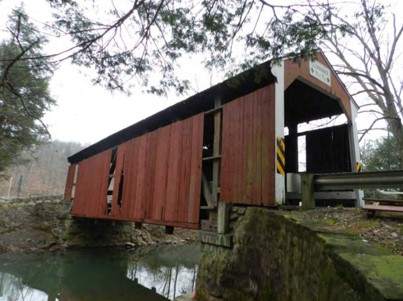
West and south elevations prior to rehabilitation. Source: Determination of Effect Report, T-526 (Covered Bridge Road) over Lower Little Swatara Creek (Zimmerman Bridge/Schuylkill County Bridge #114), February 25, 2020, Lotus Environmental Consulting, LLC.
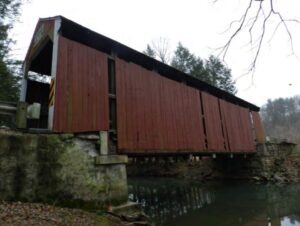
East and south elevations prior to rehabilitation. Source: Determination of Effect Report, T-526 (Covered Bridge Road) over Lower Little Swatara Creek (Zimmerman Bridge/Schuylkill County Bridge #114), February 25, 2020, Lotus Environmental Consulting, LLC.
The project received Federal funding toward the rehabilitation, which required the County and PennDOT (on behalf of the Federal Highway Administration) to consider effects of the project on the National Register-listed bridge as per Section 106 of the National Historic Preservation Act of 1966. As part of the Section 106 process, the agencies worked with the Schuylkill County Commissioners, Schuylkill County Planning & Zoning Commission, Washington Township Board of Supervisors, Barns and Bridges of New England, Theodore Burr Covered Bridge Society of Pennsylvania, National Society for the Preservation of Covered Bridges and adjacent property owners as Consulting Parties to review if the scope of work conforms to the Secretary of the Interior’s Standards for Rehabilitation (Standards) while meeting the project needs.
The Standards focus on retaining historic material where possible, replacing material that cannot be repaired, and avoiding changes that alter the characteristics that represent its historic or engineering significance. The scope of work for the Zimmerman Covered Bridge rehabilitation met these criteria.
J.D. Eckman, Inc., a contractor from Chester County, performed the rehabilitation in 2023. They secured the truss, lifted it off the abutments, and placed it adjacent to the stream, where they carefully rehabilitated and replaced members in-kind.

J.D. Eckman crew lifting the Zimmerman Covered Bridge off the abutments in preparation for rehabilitation. Source: PennDOT.

Zimmerman Covered Bridge set beside the creek, where components were repaired when possible, and replaced in-kind where necessary. Note the new wood replacing a deteriorated section of chord. Source: PennDOT.
The structure was painted and placed back on the repaired abutments.
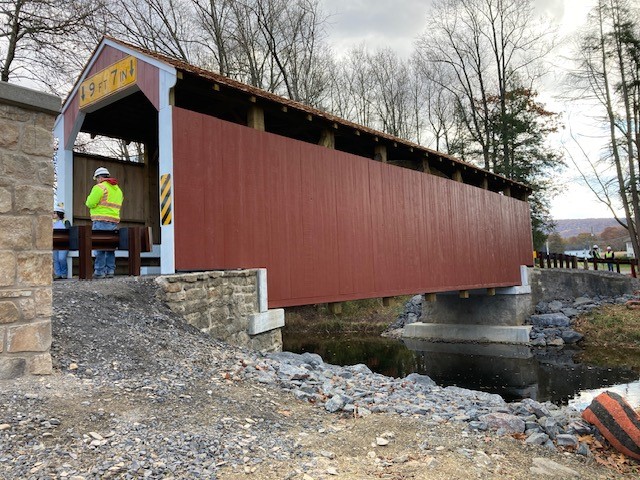
East and south elevations after rehabilitation. Source: PennDOT.
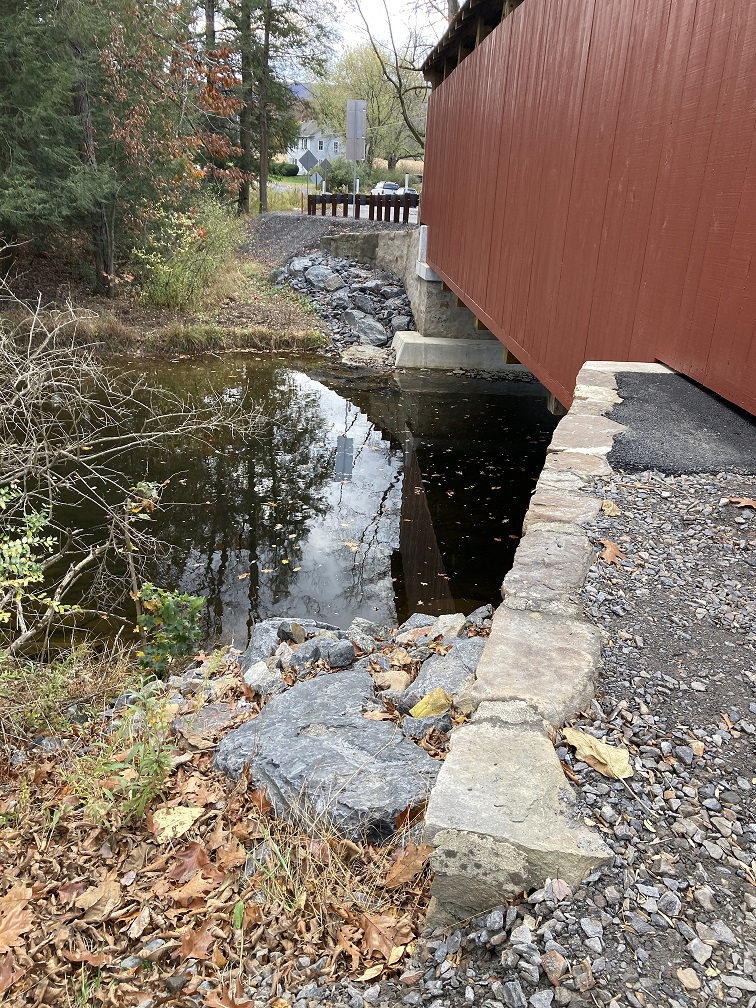
West elevation after rehabilitation. Source: PennDOT.
Covered Bridge Tours
Rehabilitation of Rock Covered Bridge and Zimmerman Covered Bridge represents the County’s investment in preserving the region’s industrial history. Over 180 covered bridges remain in Pennsylvania. Many are part of driving tours. Take some time to visit those in your community today!
Pennsylvania’s covered bridge tours include:
- Lancaster County
- Berks County
- Washington County
- Lehigh Valley
- Bucks County
- Columbia/Montour County
- Bedford County
- Susquehanna River Valley
For more information on Pennsylvania’s covered bridges, visit the Theodore Burr Covered Bridge Society of Pennsylvania’s website. Additional information on the structure type can be found in the National Park Service’s Covered Bridges: Birth of American Engineering.
References
[1] Bennett, Lola. History of Covered Bridges in the United States. Covered Bridges: Birth of American Engineering, Justine Christianson and Christoper H. Marston, Executive Editors. Historic American Engineering Record, Washington, DC, 2015, pp. 56-57.
[2] ibid, p. 67.
________________________________________________________________
This week’s guest author is Kristina Lammi Thompson. Kris is a Cultural Resources Specialist for PennDOT’s District 5 and an Above-Ground Cultural Resources Supervisor with PennDOT’s Bureau of Project Delivery.
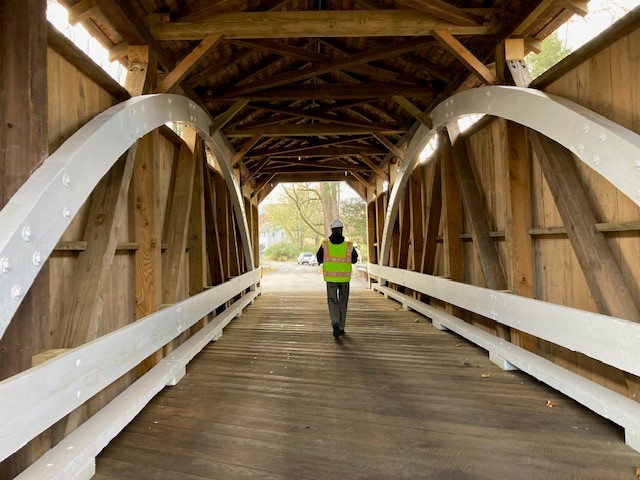
Reading about the rehabilitation of the Zimmerman Covered Bridge really took me back in time. It’s amazing to think that Schuylkill County once had fifty-one covered bridges! Now there are only two left, and they’re like precious gems holding onto our history. Learning about the Burr arch design and how it revolutionized bridge building was fascinating, especially considering the shift to iron and steel in the late 1800s. It’s great to see efforts to preserve these iconic structures for future generations to enjoy. And those covered bridge tours sound like a perfect way to spend a weekend exploring the beauty of Pennsylvania’s countryside. Who’s up for a road trip? 🌉🚗